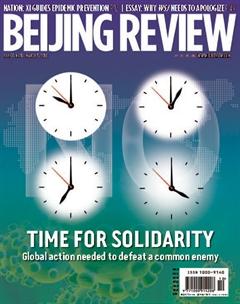WHAT CHINA CAN OFFER IN COVID-19 CONTAINMENT
By Lan Xinzhen
More than a month of intense prevention and control measures have borne fruit in China: Both new confirmed and suspected cases of the novel coronavirus disease (COVID-19) are dropping, so is the fatality rate and the number of cured and discharged patients keeps growing. The fi nal victory against the disease in the country seems within sight.
However, confi rmed cases of COVID-19 have been found in dozens of countries and regions and the number is growing. Under these circumstances, Chinas measures can serve as a reference for other countries to save lives and offset costs due to lack of experience.
China is able to pool its resources together to focus on one major mission. All resources can be arranged and deployed in a unifi ed and orderly manner. But some have a different state system that makes this type of coordination impossible.
When we say the international community can learn from Chinas experience in containing the virus, we dont mean to pitch Chinas social system, but to present its effective disease prevention and control measures.
Whether the suspension of public transportation in the epicenter Wuhan, Hubei Province, as well as the quarantining of suspected patients breach human rights should be judged by how helpful they are to the health of the vast majority of the population and whether the basic needs of those affected by these measures are met to the largest extent. In addition, these practices are accepted and espoused by the majority of people, which proves the accusations of human right violations are groundless.
Chinas best practices include early screening, reporting, quarantining and treatment; identifying all patients; admitting them to designated hospitals; engaging top-notch experts; and concentrating resources on epidemic control. Chinas practices have won recognition from the World Health Organization (WHO) and many countries. WHO Director General Tedros Adhanom Ghebreyesus noted that China is setting a new standard for epidemic response.
The outbreak is a major public health emergency that has spread quickly, caused the most extensive infection and has been the most difficult to contain since the founding of the Peoples Republic of China in 1949. It is also the fi rst time that China has adopted such measures to cope with an epidemic of this magnitude. When the worlds most populous country is able to contain the spread of the virus through effective measures, other countries will also have the means to. For example, the Republic of Korea (ROK) is similar to Zhejiang Province in east China in terms of size and population. The ROK can learn from the provinces experience in fi ghting the virus.
Moreover, the idea of a community with a shared future for humanity can be used as a guideline for disease prevention and control in the era of globalization. The implementation of this concept is essential to the success of global efforts to counter the epidemic.
After the outbreak, the Chinese Government gave top priority to protecting peoples lives. On January 11, when little was known of the virus, China was able to share information like the genetic sequence of the virus with WHO and different countries. China has been transparent with the international community throughout the process. Global moral support and material aid have boosted the Chinese peoples confi dence.
Although the virus first appeared in China, it does not mean that it is just a Chinese issue. As the situation in China improves, it is ready to lend a hand to other countries in their struggle against COVID-19. Viruses respect no borders and dont pick targets based on skin color, nationality or race. The hi-tech age has shortened distances among people. No country can keep itself immune to the threat of a virus. Once it begins to spread across the globe, the consequences can be severe.
On January 30, WHO declared COVID-19 a public health emergency of international concern for fear that the virus could spread to countries with weaker health systems. By doing so, it also called for the solidarity of the whole world. The situation demands every member of human society treat COVID-19 seriously. The world must join hands in the face of a common enemy. n

